Text and photos by Michael Marten.
In 2003 I was searching for a photo project that would express how landscape is constantly changing, not through human activities but through natural processes like weather, erosion, changes of season. On my way back south from Edinburgh, I chanced upon this tiny harbour on the coast of Berwickshire, in south-east Scotland. It’s invisible from the nearest road, but there was a track down the cliffside and rocks below that looked enticing. When I got down, I found a hand-hewn 30-metre tunnel through the red sandstone rock and beyond it the harbour, all sand and pebbles at low tide. I spent the whole day there taking pictures with my 5×4 Wista.
When I got home and had the films processed, I saw that I had taken more or less the same view of the curving teeth-like rocks outside the harbour at both low tide in the morning and at high tide in the late afternoon. The contrast between the pictures fascinated me – how the rising sea completely changed the perspective and feeling of the landscape. I immediately knew I’d found my project. So I set out to find places where there would be a dramatic visual difference between low and high tide and in the process became a student of tides!
In 2004 I returned to the Berwickshire harbour. Built in the 1830s, for a time in the late 19th century it was the third largest herring fishing harbour on the east coast of Scotland. Now it hosts two tiny boats and visitors lucky enough to know of its existence or chance upon it.
On most coasts around the world there are two tides every day, but I quickly learned that not all tides are the same. They vary hugely from place to place. In the Mediterranean the height of the tide (from low to high) is measured in centimetres. In Britain it ranges from 1 metre on parts of the North Sea coast to 15 metres (third highest in the world) in the Bristol Channel. Also, the height in any one place varies over time. Every two weeks, in the four or five days starting at new moon and full moon, the tides are higher. They are called ‘spring’ tides in English – because they rise higher, not because they have anything to do with the season of spring. In between, when the moon is waxing or waning, the tides are less high and are known as ‘neap’ tides. So high tide in the Bristol Channel might be 15 metres high at a spring tide, but less than 10 metres at neap.
That’s only one part of the rhythm of the tides. Spring and neap tides also vary throughout the year. Spring tides are highest in the months around the equinoxes, in February, March, April, and August, September, October. One of the two spring tides in each of these months is particularly high, and that’s when the Bristol Channel’s 15-metre figure is reached.
The water doesn’t just rise highest at the big spring tides, it also goes out furthest. That’s ideal for my photographs, since it is when there is the most dramatic visual difference between low tide and high tide. It’s when beaches get completely covered at flood and when rocks are most revealed at ebb.
The island of Britain isn’t big by international standards, but its coastline measures 17,800 km if you were to walk round all the headlands, bays, sea lochs and estuaries! I’ve been photographing British tides for 8 years, and I’ve still only covered a fraction of the whole coast.
So when people ask if I’m going to photograph the tides at Mont Saint-Michel or in the Bay of Fundy on the north-east coast of America, which boasts the highest tidal range in the world (16 metres), I reply that I’ve got more than enough to be going on with here at home! The British coast isn’t just long, it’s extraordinarily varied. There are long sandy beaches, white chalk cliffs, industrial estuaries, harbours large and small, tidal saltmarshes, and great sweeps of flat sand and mud like Morecambe Bay where the flood tide comes racing in faster than a galloping horse and the unwary have often been caught and drowned, including 21 Chinese cockle pickers in 2004.
Since I became interested in tides, I spend hours studying the tide tables produced by the UK Hydrographic Office (UKHO). It’s not just a question of knowing on what days the spring tides will occur in a particular year, I also need to find out the times of low and high water in each place I want to photograph. Today, for instance, high tides are at 5.45am and 6.35pm in Southampton, 8.40am and 9.18pm at London Bridge, and 10.50am and 11.45pm at Newcastle. Tomorrow all these times will advance between 20 minutes and 45 minutes, and the same the next day and the day after.
The UKHO is a branch of Britain’s ministry of defence. The tide tables they produce are published as thick books detailing times of high water and low water, tide heights, and other parameters throughout the year for all the harbours around the British Isles – and there are a lot of harbours.
The more I photographed the tides, the more fascinated I became by their complex variations. So I got in touch with the UKHO to see if I could talk to someone who might be able to answer some of my questions. Like, why is one of the two high tides each day always a bit higher than the other one (‘diurnal variation’)? And is it true that the tides don’t just slop back and forth from one side of a sea or ocean to the other, but are in fact a kind of circular wave that rotates every 12 hours around a ‘point of no tide’ called the amphidromic point? The UKHO, it turned out, employs a Head of Tides and a Deputy Head of Tides and these two scientists very kindly spent a couple of hours one afternoon answering my questions.
The tides, I was taught in school, are caused by the gravitational pull of the moon on the waters of the earth. In fact the moon contributes two thirds of the effect and the sun one third. When moon and sun are more or less in line with earth – as happens around full moon and new moon – their pull is combined and causes spring tides. When moon, sun and earth are out of alignment, the pull of the bodies tends to cancel out and we get neap tides. It is the interplay of the moon’s pull as it orbits earth, and the sun’s pull as it is orbited by earth and moon, that makes the rhythms of the tides so complex.
The time between high and low tide averages 6 hours 20 minutes, but this is just an average. In some places the tide may take 8 or 9 hours to come in, but only 3 or 4 hours to go out again; or vice versa; or anywhere in between. And even where the timing of the tides is close to the average, it will change from day to day: so today it may take 6 hours 17 minutes for the tide to rise in the pretty harbour of St Ives, in Cornwall, tomorrow 6 hours 30 minutes, and the day after 6 hours 8 minutes.
The answer to the question about whether tides are rotating waves is: yes, they are. In the North Sea, for example, there are three separate systems, or tidal gyres, that circulate anti-clockwise. Each one rotates around its own point of no tide. You can visualise the tide as a flat plate like a computer disc or a vinyl record that is slightly tilted. The side of the plate that sticks up represents high tide, the opposite side is low tide. As the plate revolves, high and low tide sweep round. In the southern part of the North Sea, for instance, the wave of high tide sweeps down the east coast of England, then crosses over to travel along the coasts of Holland and north-west Germany before sweeping up the west coast of Denmark and then crossing back over to England. When the tide is high on the English coast it is low in Denmark, and vice versa.
So tides are really circulating tidal waves, a kind of cyclical, twice-a-day tsunami to which all forms of tidal life have adapted, from algae and mussels to surfers and yachtsmen. When a real tsunami approaches a coast, the waters first recede from the shore and then return in the tidal wave. This is a high-speed version of the ebbing of the waters at low tide which then flood back at high tide.
I’ve been told that some of my tidal diptychs have a serene, timeless quality, and people therefore wonder if making the pictures is also a serene business of setting up the camera, taking the first picture at low (or high) water, and then gazing happily out to sea for 6 hours until the tide comes in (or goes out). In reality the project has rarely been that relaxed. On the contrary!
I usually go to a section of coast – north-west Wales, for example, or the Thames estuary – for the five days of a high spring tide. I try to leave a couple of days early so that I can explore the whole area and scout out locations. This needs to be done when the tide is out, so that one can see what will be covered and revealed as the sea comes and goes. I select a number of possible views up and down a stretch of coastline, sometimes as much as 75 kilometres apart. Even in one location I often have two or three different viewpoints. High water is always a very busy time. Visually, the tide is at full for about one hour. In that time I try to shoot several views and maybe two or three locations, rushing on foot or by car from one to the other. Low tide tends to be a little more relaxed, as the water appears to be far out for three or even four hours.
When I take the first picture of a tidal pair, I mark the position of my tripod with sticks or stones or scratch marks on rocks so that I can set up in the same position 6 hours later, or the next day. I also place a sheet of tracing paper, cut to 5×4, on the camera’s ground glass screen and trace with a pencil the key lines that will remain unchanged when the tide comes in or goes out – a rock, maybe, or harbour wall or distant headland, and of course the horizon. This allows me to frame the second image of the diptych exactly the same as the first. Since I started also using a digital camera (Phase One), I use a grid focusing screen and make detailed notes of where key features in the scene relate to particular lines of the grid.
Studying the tides makes clear that in spite of all the power of humans to shape, manipulate and harm the planet, its deep rhythms remain beyond our influence. In its geological and many of its other natural processes, the earth is stronger, subtler, more persistent than we sometimes imagine. Nonetheless, many of the views in my pictures probably will have ceased to exist in 100 or 200 years’ time, when global warming has caused sea levels to rise by several metres. For life in coastal towns and cities around the world, the change will be devastating. But from the planet’s perspective it will be just a minor episode. Sea levels have varied by more than 100 metres during the ice ages – a deeper, slower, climate-driven kind of tide that rises and falls over tens and hundreds of thousands of years instead of twice a day!
Visit Michael Marten for more sea tide photos.

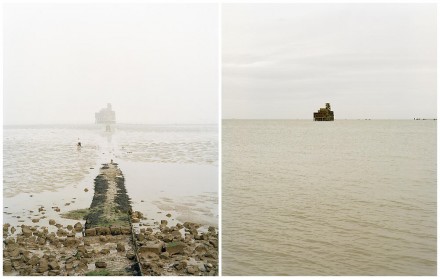
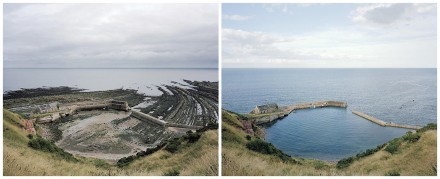
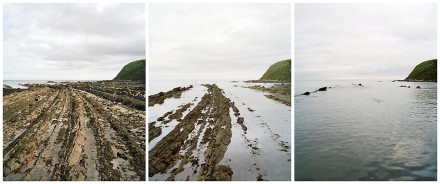
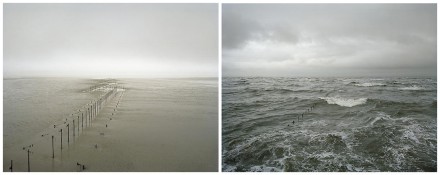
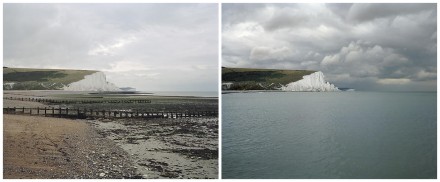

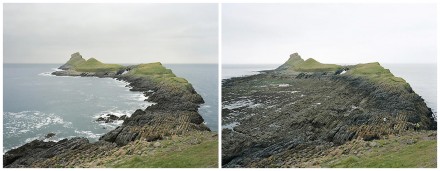

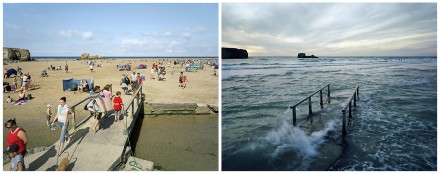
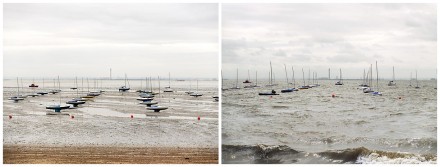
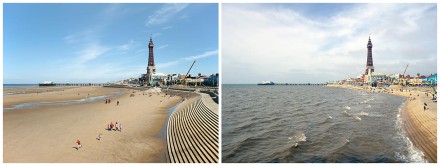
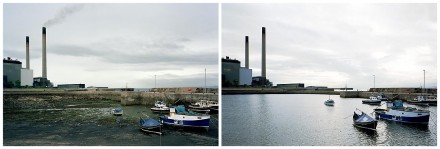

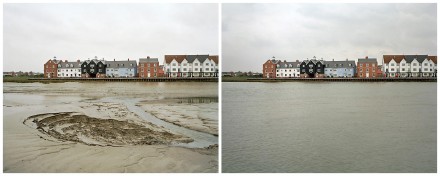
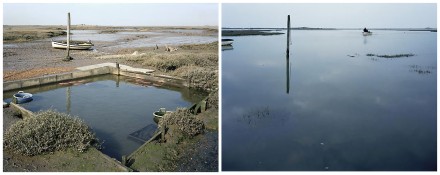
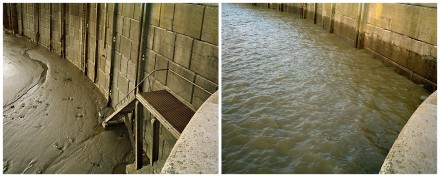
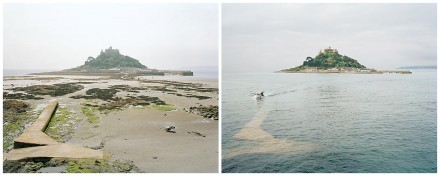
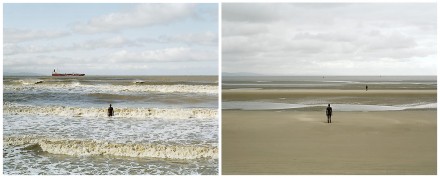
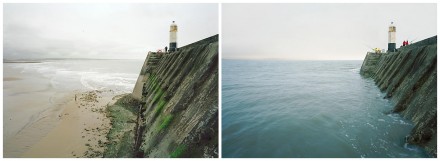
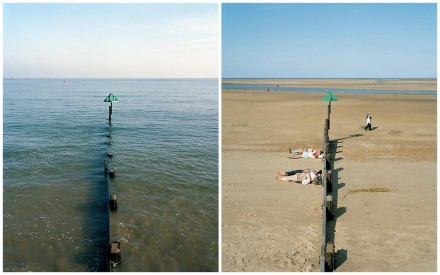




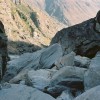





























E’ possibile vedere queste stesse foto, nella mostra personale che Michael Marten espone, fino a giorno 20 maggio 2011, presso la LIBRERIA DEL MARE in via Cala 50 a Palermo
This is a wonderful series- the push and the pull of the left and right image, the way they play against/ with each other is fascinating.
Stunning images of dispassionate reflection on our changing coastal perimeter. They combine the coolness of the scientific observer with the sensitivity of the creative artist.
I am a friend & colleague of Mr Marten and I attended his first exhibit of Sea Change in the US. Imagine huge color prints mounted side by side in a gallery setting. It was nothing less then spectacular.
I saw some of these wonderful pics on the magazine “E” (the new magazine of Emergency, http://www.e-ilmensile.it/) and found the job great … it brings one to a kind of peace and serenity by becoming the awareness that the big and powerful rythms of the nature happen every day with their whole wonder, even the most of the humanity does not take care of that and keep being occupied with project of power, or war, or distruction, etc. … A very nice feeling … Thanks Michael !!
excelente !!++++++++++++++++
You can also subscribe to this post comments RSS feed.